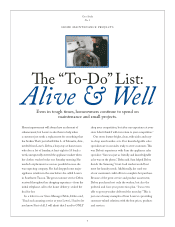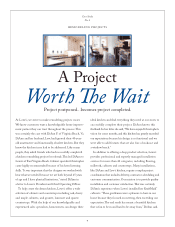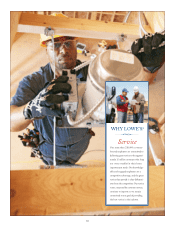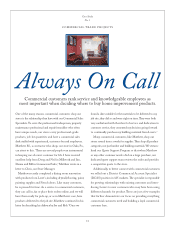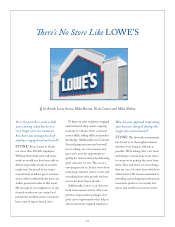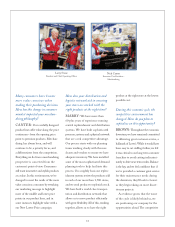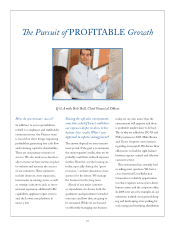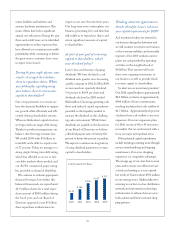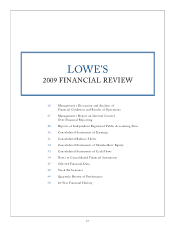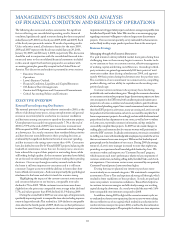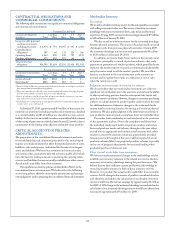Lowe's 2009 Annual Report Download - page 18
Download and view the complete annual report
Please find page 18 of the 2009 Lowe's annual report below. You can navigate through the pages in the report by either clicking on the pages listed below, or by using the keyword search tool below to find specific information within the annual report.
expect to use over the next three years.
Our long-term view contemplates our
business generating free cash fl ow that
will enable us to repurchase shares and
return signifi cant amounts of capital
to shareholders.
As part of your goal of returning
capital to shareholders, what’s
your dividend policy?
Lowe’s has a rich history of paying
dividends. We have declared a cash
dividend each quarter since becoming
a public company in 1961. In May 2009,
we increased our quarterly dividend
5.9 percent to $0.09 per share and
dividends declared in 2009 totaled
$522 million. Our strong operating cash
fl ows and reduced capital expenditure
provided us the liquidity needed to
increase the dividend in this challeng-
ing sales environment. While future
dividends are payable at the discretion
of our Board of Directors, we believe
a dividend payout ratio of twenty-fi ve
percent to thirty-fi ve percent is prudent.
We expect to continue our long history
of using dividend payments to return
capital to shareholders.
16
center forklifts and batteries and
systems hardware maintenance. is
team’s eff orts have led to signifi cant
annual cost reductions. During the past
three-and-a-half years, we’ve identifi ed
opportunities to reduce expenses that
have allowed us to maintain reasonable
profi tability while continuing to deliver
the great service customers have come
to expect from Lowe’s.
During the past couple of years, some
retailers leveraged their balance
sheets to repurchase shares. What’s
your philosophy regarding using
your balance sheet to return more
capital to shareholders?
One of my priorities is to ensure we
have the fi nancial fl exibility to support
our growth while eff ectively and effi -
ciently driving shareholder returns.
When we think about capital structure,
we begin with our target debt rating.
anks to prudent management, our
balance sheet leverage remains low.
We ended 2009 with $5 billion in
total debt and a debt-to-equity ratio
of 27 percent. Today, we manage to a
strong single-A long-term debt rating,
which has aff orded us access to low-
cost debt markets when needed, and
our A1/P1 commercial paper rating
has provided us fi nancial fl exibility.
We continue to evaluate appropriate
fi nancial leverage, but within this
balanced framework, we repurchased
21.9 million shares for a total repur-
chase amount of $500 million during
the fiscal year, and our Board of
Directors approved a new $5 billion
share repurchase authorization we
inking about the opportunities
that lie ahead for Lowe’s, what are
your capital requirements for 2010?
As I mentioned earlier, we invested in
our business during the downturn and
we will continue to invest in our business
as the economy stabilizes and eventually
improves. Our 2010 outlook contem-
plates net cash provided by operating
activities in the neighborhood of
$4 billion. at amount will more
than cover ongoing investments in
our business as well as provide funds
to return capital to shareholders.
So what are our investment priorities?
Our 2010 capital budget is approximately
$2.1 billion, inclusive of approximately
$400 million of lease commitments,
resulting in planned net cash outfl ow of
$1.7 billion. Approximately 62 percent
of planned net cash outfl ow is for store
expansion. Our store expansion plans
for 2010 consist of 40 to 45 new stores
in markets that are underserved, with a
focus on major metropolitan areas.
Other planned capital expenditures
include investing in existing stores through
resets, remerchandising and ongoing
maintenance. Our store shopping
experience is a competitive advantage.
e average age of our store base is seven
years, and to ensure our oldest stores are
as fresh and inviting as a store opened
last week, we’ll invest about $350 million
in our existing stores. Additionally, we’re
investing in our best-in-class distribution
network and information technology
infrastructure to enhance how we serve
both current and future customer shop-
ping patterns.
Cash Dividends Per Share
2005 2009200820072006
$.110
$.355
$.335
$.290
$.180



